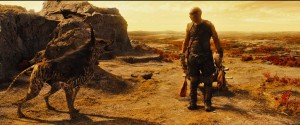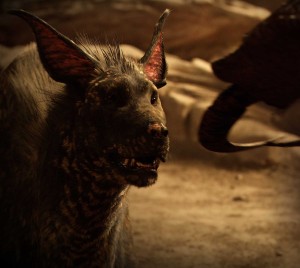![]()
 Montreal-based Mokko Studio provided 321 shots, (more than 25 minutes of content), for Universal’s Riddick starring Vin Diesel.
Montreal-based Mokko Studio provided 321 shots, (more than 25 minutes of content), for Universal’s Riddick starring Vin Diesel.
Working for more than a year in close collaboration with the film’s director, David Twohy, and led by studio co-founder Alain Lachance, with a crew of more than 100 artists, Mokko created extensive creature work on the mud demons and jackals, including pups. The company also built five different sets including full CG environments and matte paintings. Working from original drawings and basic creature designs done by Patrick Tatopoulos, Mokko’s art director Arnaud Brisebois and his team of modelers and texture artists pushed the original designs further and created ZBrush sculpts for the director, who used them to judge proportions and size before the final modeling stage.
According to Lachance, “It was important for us and production to base our art on nature, on something plausible, even if we were on a different planet. Nothing was left to improvisation, from the bone structure necessary to have the jackal’s ears open in a very specific way that the director had imagined to the mud demons breathing holes in their tails.”
 Mokko’s pre-production work also included extensive R&D testing to develop tools and techniques for water and mud simulations. “It was important to determine the correct scale, viscosity and density of the water and mud right from the start, based on the shots we knew David was going to shoot,” said Lachance. “We had to match the water and mud perfectly to the elements they were using on set. But, we also had these huge creatures jumping out of the water, adding an extra level of complexity.”
Mokko’s pre-production work also included extensive R&D testing to develop tools and techniques for water and mud simulations. “It was important to determine the correct scale, viscosity and density of the water and mud right from the start, based on the shots we knew David was going to shoot,” said Lachance. “We had to match the water and mud perfectly to the elements they were using on set. But, we also had these huge creatures jumping out of the water, adding an extra level of complexity.”
After extensive testing and tweaking of their Renderman pipeline, Mokko chose Autodesk’s Naiad for the water simulation and Yeti Fur for the jackals’ hair.
One of the most difficult aspects of the film was getting a believable performance from Riddick’s pet jackal. In stark contrast to Riddick’s normal demeanor and the harsh alien world environment, the emotional connection between jackal and man was a challenge. Making sure the jackal, especially as a puppy, conveyed believable emotion required creation of an extensive rigging system that gave the animators maximum flexibility when it came to facial controls.
The mud demons, who literally take over the screen in some shots, posed their own set of challenges, especially when it came to movement. How would one run? How would it distribute its weight jumping out of the water? How much flexibility should their tail have? Again, Mokko’s artists did extensive walk/run/jump studies to determine the most believable creature movements.
 Of course, you can’t have a mud demon without having mud. Water and mud go hand in hand. “Water simulation is always complex technically and artistically,” said Lachance. “What made these shots most challenging was that we had to seamlessly extend the live action water in which Riddick was standing with our CG water that needed to interact with the mud demon. Great lighting and compositing was essential and indispensable for making this work. I was even fooled at times about where the transitions were between the live water and our CG simulations.”
Of course, you can’t have a mud demon without having mud. Water and mud go hand in hand. “Water simulation is always complex technically and artistically,” said Lachance. “What made these shots most challenging was that we had to seamlessly extend the live action water in which Riddick was standing with our CG water that needed to interact with the mud demon. Great lighting and compositing was essential and indispensable for making this work. I was even fooled at times about where the transitions were between the live water and our CG simulations.”
The jackal’s movements were based on dogs. For reference, the crew film trained dogs walking, running and jumping on greenscreen with grid patterns. “It was important for the director that our animators capture the unscripted animations of the jackal,” explained Lachance. “What would a real jackal do when not receiving commands from its trainers? The crew solved that problem by bringing into the studio the animators’ dogs to study every movement carefully, especially when the dogs were not performing for their owners. One of the shots has a jackal sneezing. It wasn’t part of the script, it wasn’t part of the concept, but that’s what dogs do. So, we just threw that in and it just made the shot much more real.”





